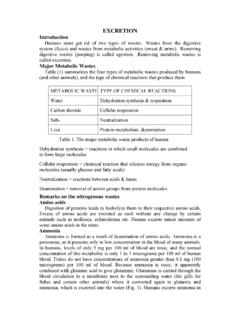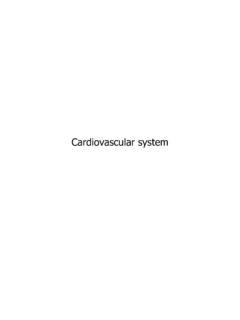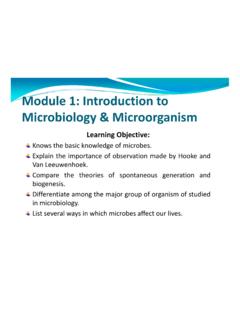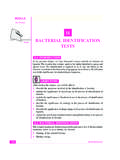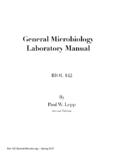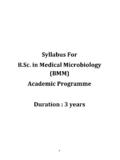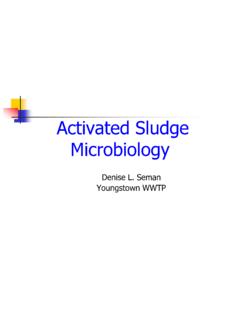Transcription of Introduction - Mans
1 Introduction Disinfectants used in hospitals and laboratories must be tested periodically to ascertain its potency and efficacy. Evaluation is not for it is for the activity of the agent under certain conditions and usesDisinfection process validationDefined as:"establishing documented evidence that a disinfection process will consistently remove or inactivate known or possible pathogens from inanimate objects."Factors affecting the disinfection process:Effect of temperature; Bacteriologist Koch had noted that anthrax spore were more readily killed by the same concentrations of phenol if the temperature was of pH;Any change in PH will affect: Rate of growth of bacteria >> growth is optimal at pH (6-8).
2 Potency of antimicrobial agent >> due to ionization at pH. Ability of drugs to combine with cell surface sites of of surface activity; The addition of low concentrations of surface active compounds may potentiate the biological effect of an antibacterial of interfering substances; The presence of other material may reduce the effect of such an agent by adsorbing or inactivating it and thus reducing the amount available for combining with the cells it is desired to tests Carrier test Suspension test Capacity test Practical test In-use test Carrier testPrinciple: A carrier such as a silk or catgut thread is contaminated by submersion in a liquid culture of the test organism.
3 The carrier is then dried and brought in contact with the disinfectant for a given exposure time. cultured in a nutrient broth; No growthindicates activity of the disinfectant tested whereas growthindicates a failing. By multiplying the test concentrations of the disinfectant and the contact times, a potentially active concentration-time relationships of the disinfectant is obtained. Limitationsa) The number of bacteria dried on a carrier is hard to standardize b) The survival of the bacteria on the carrier during drying is not AOAC Use-dilution test AOAC (American Association of Official Analytical Chemists) A carrier-based test.
4 Organisms:Salmonella cholerasuis, S. aureus and P. aeruginosa. Carriers (stainless steel cylinders)are meticulously cleaned, sterilized, cooled and inoculated with a test organism by immersing in one of the culture suspensions. The cylinders are drained on filter paper, dried at 37 C for 40 minutes, exposed to the use-dilution of the disinfectant for 10 minutes. After transfer from the disinfectant, the treated test surfaces are incubated in the neutralizing growth medium for 48 hours. The number of tubes showing growth of the target microorganism is recorded.
5 To "pass" a 60 carrier test, at least 59 of the 60 surfaces tested must demonstrate complete disinfection (no detectable growth of the target microorganism in the test tubes containing neutralizing growth medium). To "pass" a 10 carrier test, complete disinfection must take place on all test testsPrinciple: A sample of the bacterial culture is suspendedinto the disinfectant solution After exposure it is verified by subculture whether this inoculum is killed or not. Suspension tests are preferred to carrier tests as the bacteria are uniformly exposed to the disinfectant.
6 Types a) Qualitative suspension tests: A loopful of bacterial suspension brought into contact with the disinfectant A loopful of this mixture cultured for surviving organisms. Results expressed as growth or no growth .B) Quantitative suspension tests. The number of surviving organisms (B) is counted and compared to the original inoculum size (A). microbicidal effect (ME) = Log (A) -Log (B)ME = 1 killing of 90% of the initial number ME = 2 99% killed. A generally accepted requirement is: ME 5 of the germs are killed.
7 C) Phenol coefficient: Phenol coefficient of a disinfectant is calculated by dividing the dilution of test disinfectant by the dilution of phenol that disinfects under predetermined of phenol coefficient1-Rideal Walker method: Organism: Salmonella typhi suspension. Temp: 20 C Subcultures are performed from both the test and phenol at intervals of , 5, and 10minutes. The plates are incubated for 48-72 hours at 37 C. Growth or no growth phenol coefficient= That dilution of disinfectant which disinfects the suspension in a given time is divided by that dilution of phenol which disinfects the suspension in same time Disadvantages of the Rideal-Walker test:1-No organic matter is included.
8 2-Microorganism Salmonella typhi may not be appropriate. 3-Time allowed for disinfection is short. 4-Used to evaluate phenolic type disinfectants Martin test: Organism: mixture of S. typhi + dried yeast (organic load) Temp: 30oC Recovery media after contact time 30 min (loopful)---incubate at 37oC for 48hr Growth or no growth phenol coefficient = mean of lowest conc. of phenol prevent growth in subculture/ unknown disinfectant(The phenol coefficient is lower than that given by Rideal Walker method)Capacity testsPrinciple: The ability to retain activity in the presence of an increasing load is the capacity of the disinfectant.
9 In a capacity test, the disinfectant is challenged repeatedly by successive additions of bacterial suspension until its capacity to kill has been exhausted. Capacity tests simulate the practical situations of housekeeping and instrument disinfection. Best known capacity test is the Kelsey-Sykes test(Kelsey and Sykes, 1969).Kelsey-Sykes test A triple challenge test, designed to determine concentrations of disinfectant that will be effective in clean and dirty conditions. Organisms:4 organisms (S. aureus, , P. aeruginosaand Proteus vulgaris) Three successive loadsof bacteria (additions) (0, 10, and 20 min) Temp:20oC Calibrated pipette for subculture rather than loop Clean and dirty conditions Assessment (kill or not) (no phenol coefficient) Sets that contain two or more negative culturesare recorded as a negativeresult.
10 The disinfectant passes at the dilution tested if negative results are obtained after the first and second challenges. The third challenge is not included in the pass/fail criterion but positive cultures serve as inbuilt controls. If there are no positive cultures after the third challenge, a lower concentration of the disinfectant may be tested. Good guideline for the dilutionof the preparationto be used. Disadvantage of this test: complicated. ModifiedKelsey-Sykes method. Test for stability and long-term effectiveness Recommended concentrations based on Kelsey Sykes test apply only to freshly prepared solutions but if the solutions are likely to be kept for more than 24 hours, the effectiveness of these concentrations must be confirmed by: Supplementary testfor stability of unused solution and for the ability of freshly prepared and stale solutions to prevent multiplication of a small number of bacteria that may have survived the short term exposure.
